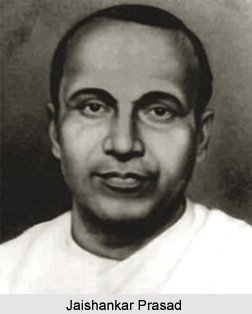 Chhayavad in Hindi literature was a trend in the 1920s and the 1930s when there was seen the profusion of a literature that exhibited a romanticism and mysticism, especially in poetry. Chhaya, which literally translates as "a reflection, an image in a mirror," emerged as a revolt against Khadi boli poetry, which had replaced Braj poetry by the beginning of the twentieth century. As a result of the efforts of the Orthodox Hindus to propagate the use of Hindi language, Khadi Boli had experienced a formalistic transformation that imparted a literary character to the language. The poetry that emerged out of Hindu revivalism was full of the images of a lost past. They reflected communal and revivalist ideals and strong feelings of patriotism and nationalism. However, these feelings were coloured by the Hindu ideals which did not help in encouraging secular ideals or in the development of a more progressive Indian society.
Chhayavad in Hindi literature was a trend in the 1920s and the 1930s when there was seen the profusion of a literature that exhibited a romanticism and mysticism, especially in poetry. Chhaya, which literally translates as "a reflection, an image in a mirror," emerged as a revolt against Khadi boli poetry, which had replaced Braj poetry by the beginning of the twentieth century. As a result of the efforts of the Orthodox Hindus to propagate the use of Hindi language, Khadi Boli had experienced a formalistic transformation that imparted a literary character to the language. The poetry that emerged out of Hindu revivalism was full of the images of a lost past. They reflected communal and revivalist ideals and strong feelings of patriotism and nationalism. However, these feelings were coloured by the Hindu ideals which did not help in encouraging secular ideals or in the development of a more progressive Indian society.
The chhayavadis revolted against this rigid control of poetry, which severely curtailed artistic freedom. They propagated the free flow of artistic expression, through which they expressed the problems and disillusionment of the individual in a world gone wrong. The shift toward romanticism was also symbolic of the writers` protests against British colonialism. By the end of World War I, British exploitation had reached its peak, and the nationalist struggle was at its height. Romantic writers sought an escape from the tedious conditions of life by creating an imaginary world for themselves. To look for solutions to existing political problems, the chhayavadis turned to an infinite transcendental reality, holding on to the expression of mysticism and spiritualism. The chhayavadi phase emerged from the cultural conditions within Indian society and thus differed from the Romantic Movement in the West.
The chief proponents of the Chhayavad movement were Jaishankar Prasad, Suryakant Tripathi `Nirala`, Sumitranandan Pant, and Mahadevi Verma. Nirala`s first romantic poem, entitled "Juhi Ki Kali" (The Bud of Jasmine) was published in 1923. Within a short span of time, poets such as Makhan Lal Chaturvedi, Ram Kumar Verma, Bhagvati Charan Verma, Harivanshrai Bachchan, Narendra Sharma, Uday Shankar Bhatta, and Kedar Nath Bhatta became established as romantic poets. Preoccupied with symbolist experiments, poetic lyricism, and mysticism, the nationalistic themes of the Chhayavadi writers became replete with such imagery. Nirala`s Anamika (1937) is the most representative collection of the Chhayavadi writers. Others, such as Pant`s collection of poems Vani (1927), Pallava (1928), and Gunjan (1932), express the loneliness of the poet in a world of chaos.
The revolutionary upsurge in literature and the concern with mass nationalist struggle caused a shift from the personal struggles undertaken by the romantics to a depiction of the struggles of the masses. Chhayavadi writers such as Jaishankar Prasad, Suryakant Tripathi `Nirala` (1896-1961), Sumitranandan Pant, and Mahadevi Verma started finding their preoccupations with the lyrical charm and idyllic beauty of poetry limited and moved on to explicit social themes. Poems such as Mahadevi Verma`s "Yama" and "Deepshikha" (1940), Harivanshrai Bachchan`s "Madhushala" (1935), and Pant`s "Yuganta" (1939) and "Gramya" (1940) are reflective of this shift. The poems portray poverty, social inequality, and village life. Surya Kant Nirala`s Kukurmutta (1941) is a powerful attack on the British and Indian ruling classes through the Kukurmutta`s (mushroom`s) chastisement of the rose, which is presented as a metaphor for the capitalistic designs of the rulers.
Thus, the Chhayavad movement in Hindi literature was a definite shift away from the earlier pre-occupations of the writers to a Romantic mysticism.













